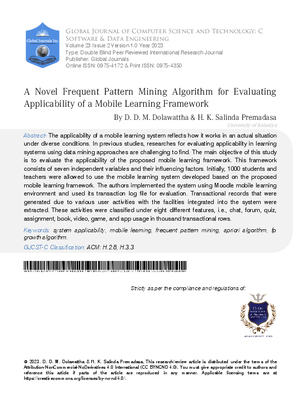Abstract
The applicability of a mobile learning system reflects how it works in an actual situation under diverse conditions In previous studies researches for evaluating applicability in learning systems using data mining approaches are challenging to find The main objective of this study is to evaluate the applicability of the proposed mobile learning framework This framework consists of seven independent variables and their influencing factors Initially 1000 students and teachers were allowed to use the mobile learning system developed based on the proposed mobile learning framework The authors implemented the system using Moodle mobile learning environment and used its transaction log file for evaluation Transactional records that were generated due to various user activities with the facilities integrated into the system were extracted These activities were classified under eight different features i e chat forum quiz assignment book video game and app usage in thousand transactional rows A novel pattern mining algorithm namely Binary Total for Pattern Mining BTPM was developed using the above transactional dataset s binary incidence matrix format to test the system applicability Similarly Apriori frequent itemsets mining and Frequent Pattern FP Growth mining algorithms were applied to the same dataset to predict system applicability
This work is licensed under a Creative Commons Attribution 4.0 International License.
Copyright (c) 2023 Authors and Global Journals Private Limited

